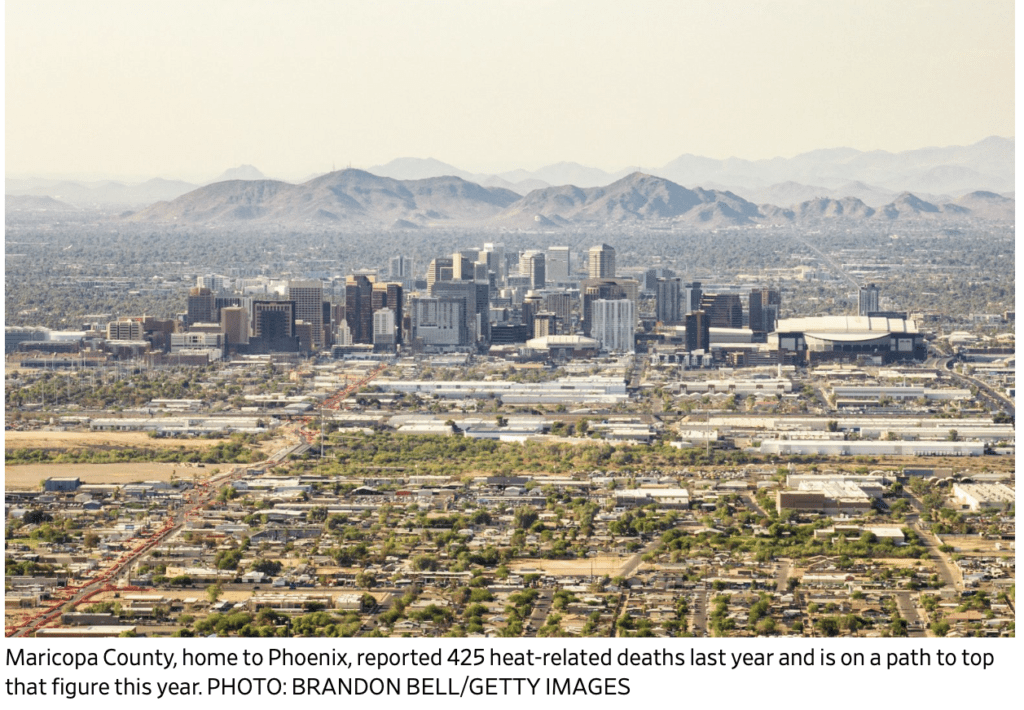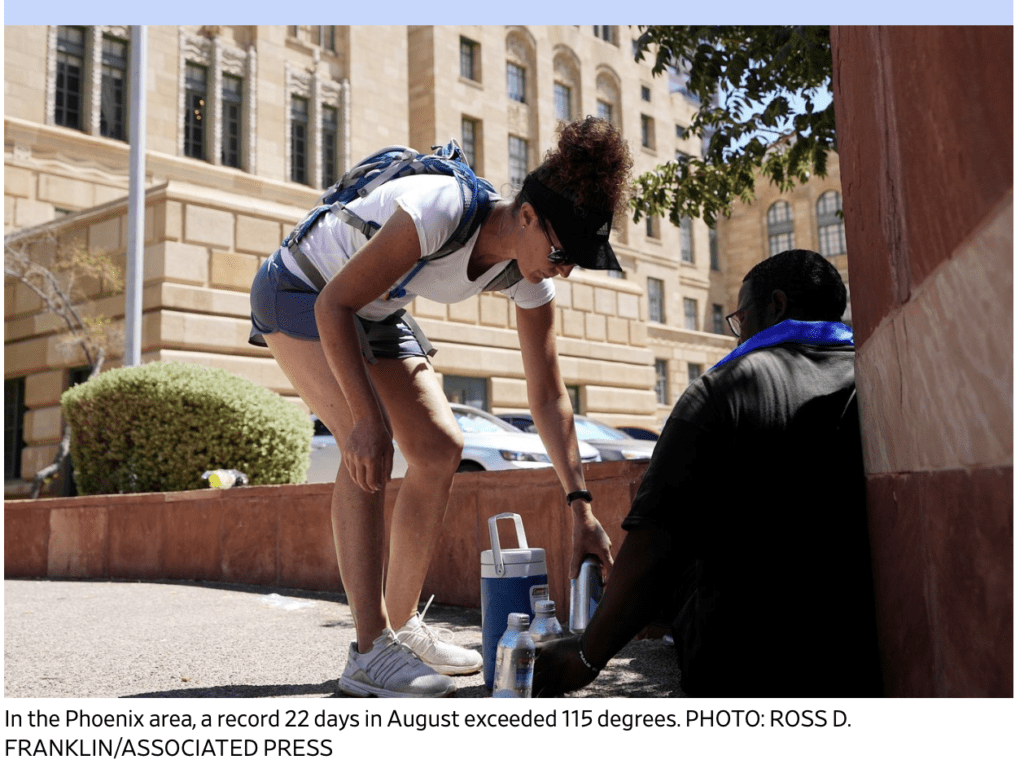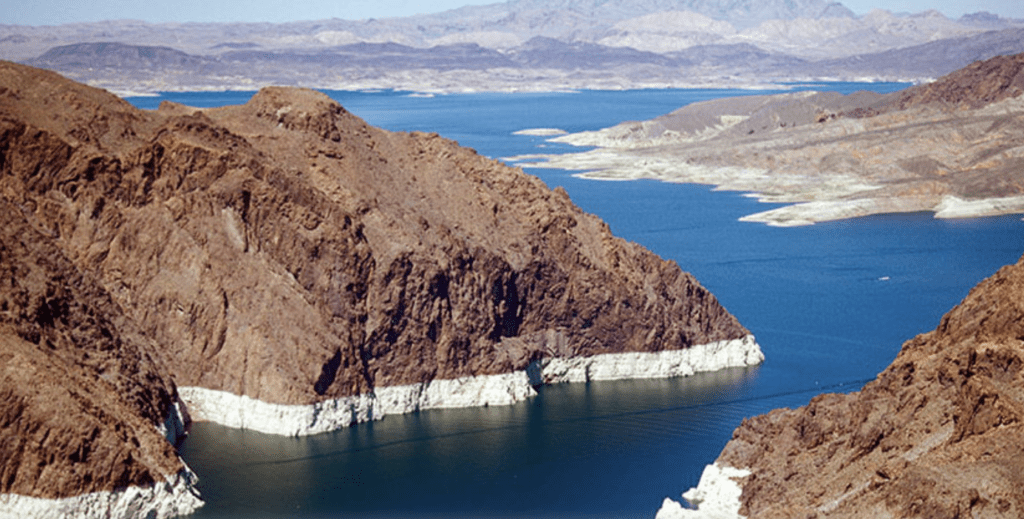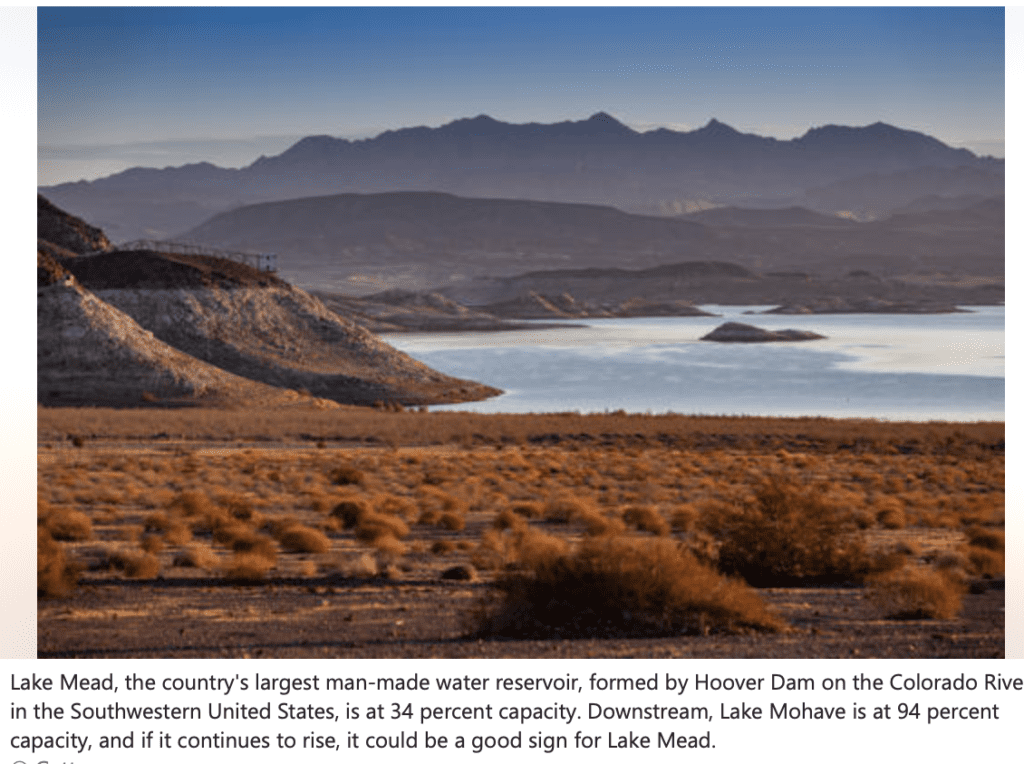Daniel Salzler No. 1220
EnviroInsight.org Four Items September 22, 2023
—————Feel Free To Pass This Along To Others——————
If your watershed is doing something you would like others to know about, or you know
of something others can benefit from, let me know and I will place it in this Information .
If you want to be removed from the distribution list, please let me know.
Please note that all meetings listed are open.
Enhance your viewing by downloading the pdf file to view photos, etc.
The attached is all about improving life in the watershed.
If you want to be removed from the distribution list,
please let me know. Please note that all meetings listed are open.
Check our website at EnviroInsight.org
1. Record Heat Deaths in Arizona Spur Push for Disaster Assistance
Local officials say heat waves, which have killed hundreds in Phoenix this year, should be treated like hurricanes and wildfires.
Debra and Paul McKnight lived in the desert Southwest for about a dozen years and were used to temperatures in the 100s. When their truck broke down on a drive in Arizona last month, it was 118 degrees.

With no water on hand, the couple got out to look for help. Paul soon noticed that Debra, 46 years old, could barely walk. He eventually got water from a creek half a mile away, but by the time he returned, she was severely dehydrated. They eventually got help from a passerby three hours after they broke down, but Debra died soon after of heat stroke.
“I was trying to find any way to cool her off that I could,” Paul McKnight recalled. “She was just too far gone. I’ve thought about it a million times trying to think of different ways I could have helped her.”
With deaths rising in Arizona as the state breaks high-temperature records year after year, a coalition of local leaders including Phoenix Mayor Kate Gallego, a Democrat, are calling for the Federal Emergency Management Agency to categorize heat waves as natural disasters, like wildfires, hurricanes and floods.
Researchers say heat kills more Americans than any other weather-related event, though the data collection is inconsistent across jurisdictions. The Centers for Disease Control and Prevention recorded some 1,700 heat deaths in the U.S. last year, which researchers say is almost certainly a significant undercount. Studies of excess deaths have pegged the number at closer to 10,000 annually. Maricopa County, home to Phoenix, reported 425 heat-related deaths last year and is on track to exceed that figure this year.
The problem is particularly acute in Arizona: The state endured an unprecedented 31 straight days above 110 degrees between June 30 and July 30. In the Phoenix area, a record 22 days in August exceeded 115 degrees.

“It was the hottest summer on record,” said Matthew Hirsch, lead meteorologist at the National Weather Service’s Phoenix office. “But the hottest summer on record has actually happened five times out of the past 11 years. So we keep on breaking records.”
The Biden administration hasn’t heeded calls to add heat waves to the list of natural disasters, but the president met with Arizona officials including Gallego in July to discuss the issue. FEMA also has issued guidance on how cities and states should prepare for extreme heat events.
Rep. Ruben Gallego, a Democrat who represents the Phoenix area in Congress and was previously married to the mayor, proposed legislation in June to include extreme heat events on the list of natural disasters FEMA responds to. The bill hasn’t been taken up in a committee.
Of the 86 people who died indoors from heat-associated causes in Maricopa County, Ariz., in 2022, at least 79 didn’t have operating air conditioning.

Many of those pushing for greater recognition of the toll extreme heat takes say better data is needed. Deaths from heat stroke are easy to recognize by high core body temperatures, but for many victims, the heat is a secondary factor that contributes to other causes of death such as heart disease. Prescription medications, including for mental illness, can make it harder for the body to regulate temperature, making the patient more susceptible to extreme heat.
For deaths where heat isn’t the obvious and only culprit, classifying them as heat-related can be complicated and subjective.
“There isn’t consensus on exactly how to count,” said Gregory Wellenius, director of the Boston University School of Public Health Center for Climate and Health. “So which of those deaths should be labeled as having been due to heat and how many of those should be labeled as heat having played a role as a contributing cause? There’s not a standardized definition of how to do that.”
In Europe, where air conditioning isn’t widespread,

some 5,600 people died of heat related causes in Germany, Spain and Italy this summer amid record-high temperatures, according to preliminary tallies.
In U.S. states such as Arizona, where most homes have air conditioning, heat deaths are typically caused when people are outside or have AC units that don’t work or they are wary of turning them on because of the expense.
No local jurisdiction tracks heat-related deaths as aggressively as Maricopa County, home to Phoenix, according to researchers. One of the hottest urban areas in the U.S., the county started tracking such deaths in 2006.
So far this year, heat has killed or contributed to the deaths of at least 202 people in Maricopa County, according to the county’s medical examiner’s office. The deaths

of roughly 356 people are still under investigation.
“Regardless of how these investigations fall out, we are going to have a record number of heat-related deaths this year,” said Nick Staab, a medical epidemiologist and assistant medical director for Maricopa County.
The county, home to about 4.5 million people, has reported a record number of heat-related deaths every year since 2016, when there were 154.
In Pima County, home to Arizona’s second-biggest city, Tucson, officials this year began tallying all heat-related deaths, rather than those directly caused by heat.
2. State Considers Using Effluent Water Credits Camryn Sanchez Arizona Capitol Times//September 15, 2023.
The Arizona Water Banking Authority is exploring the possibility of buying purified wastewater to distribute later – which would be unprecedented.

Pima authorities so far this year have recorded 101 heat-related deaths, including a record 39 in which heat was the cause of death, not just a contributing factor. Source: Wall Street Journal.
At the AWBA commission’s meeting on Sept. 13, new bank manager Rebecca Bernat asked whether she should look into the possibility of the bank using effluent water credits.
Until 2019, AWBA has only used excess Colorado River water long-term storage credits. That’s for the Central Arizona Project water stored in aquifers. Users can get the water later during a potential shortage by pumping it back out.
Now, there isn’t any excessCAP water left.
“It’s a different source for the bank,” Eric Braun, Gilbert water resources manager, said of the effluent storage. He was appointed to the commission by former Gov. Doug Ducey and said he supports the effluent water idea. “There’s no more longer use CAP entitlement water for the bank to purchase. … As the supply of those credits decreases, they’re looking for new alternatives.”
The Central Arizona Project is the only type of water the bank deals in now. The CAP canal system transports water across the Valley and not just any type of water can be added to it – which is one of a few challenges AWBA could face with effluent water.
CAP specifically does not allow effluent water to be added into the canal system, so that water would have to be moved around in other ways. Or CAP could potentially change its rules.
Effluent water is treated wastewater, but pure enough to meet drinking water standards. Like Colorado River water, it can be used to recharge aquifers and be pumped out for future use. It just comes from water treatment facilities rather than the river.
Effluent credits exist now and are purchased by various entities, but the bank has never used them and they aren’t used as much as CAP long-term storage credits (LTSCs).
This year, the Phoenix active management area (AMA) actually had a big spike in the sale of effluent water credits – larger than any other time in the past 25 years, but 87% of the AMA’s credits are CAP LTSCs and 13% are effluent LTSCs. Those numbers vary between AMAs, but CAP LTSCs are more broadly used.
The Phoenix AMA has 1,036,226 effluent credits and Tucson AMA has 323,511 LTSCs. Bernat said the other AMAs might also have effluent credits. But wherever the bank buys credits (if they decide to) needs to be where recovery of the water can happen.
Facilities that produce effluent water tend to be located in AMAs because that’s where Arizona’s population is concentrated, Bernat said.
Another thing AWBA must consider is the price difference between purchasing effluent credits and CAP credits.
Bernat said in her presentation that the data is limited because prices don’t need to be disclosed when buyers get credits, but in one case she studied in the Tucson AMA, the CAP credits were sold at $209 per acre foot and the effluent credits sold for $180. But whether effluent credits would be cheaper now remains to be seen.
Ultimately, the commission agreed to direct Bernat to investigate this potential move further. Tom Buschatzke, ADWR director and AWBA commission chair, said, “We certainly need to pursue all water resources. Many other forums are having the same types of discussions. We can’t look at it with a myopic or singular view.”
Braun said he expects that the bank’s use of effluent credits is not far off at all if they do decide to go forward with it.
“I think it’s a good idea yeah, I still need to hear about what might be some drawbacks to it, but my first inclination is that it’s a new market to try to get into,” he said.
The next AWBA meeting is scheduled for Dec. 6. Source: Arizona Capitol Times September 15, 2023
3. What Lake Mohave’s Water Level Change Means For Lake Mead’s Future.Lake Mohave is near capacity, and the healthy body of water you’d be good news for Lake Mead in Nevada and Arizona.

Lake Mead has steadily; y risen throughout the spring ad summer, jumping more than 22 feet from 2022 water levels. The rise is a hopeful sign after the lake experienced years of drought and reached drastically low level last summer, prompting fears of a dead pool – the point at which water levels are too low to flow downstream – would occur much sooner than they originally thought..
Meteorologist expect that lake mead could level off at 34% full and stop its upward trek until the winter months when precipitation is expected to return downstream, if the smaller lake Mohave fills to capacity, it’s a saying that Lake Mead could see another increase in water levels.
Downstream from Lake Mead, Lake Mohave is 94% full and that’s really good news. Parker Dam is also at 94% full even farther down stream.
Lake Mead is the largest man-made reservoir in the U.S., so even excessive amounts of rain barely increase the water levels. And despite its upward rend, water preservation efforts are ongoing as experts have told Newsweek that Lake Mead is unlikely to return full capacity unless people greatly reduce their water usage from the Colorado River.
States in the lowerColorado River Basin such as Nevada and Arizona are experiencing mandatory water cuts. Earlier tis year, Nevada, Arizona and California agreed to cut an additional 3 million acre-feet of water in exchange for a payment from the federal Government. Source: Newsweek
4. Celebrate The Passing Of Summer And The Beginning Of Fall. September 22,2023 marks the end of summer and the beginning of fall. Yeaaahhhhh!!!!!
Copyright: 2023 EnviroInsight.org
